Patagonia is one of the most wild and remotest mountain ranges in the world. And the Torres del Paine O Circuit is regarded as one of the world’s best long-distance treks. Patagonia is spread over Chile and Argentina, where the landscape features jaw-dropping mountains, icy glaciers, huge lakes, fjords and vast forests. Whilst the Argentinian side has Fitz Roy, Chile has the iconic Torres del Paine National Park, which is a bucket-list mountain view. Inside the National Park, there are the popular W Trek and the harder Torres del Paine O Circuit. This blog will explain the difference between these trek and give planning advice on booking campsites, transport and how to have the best 8-day Patagonian Trekking experience.
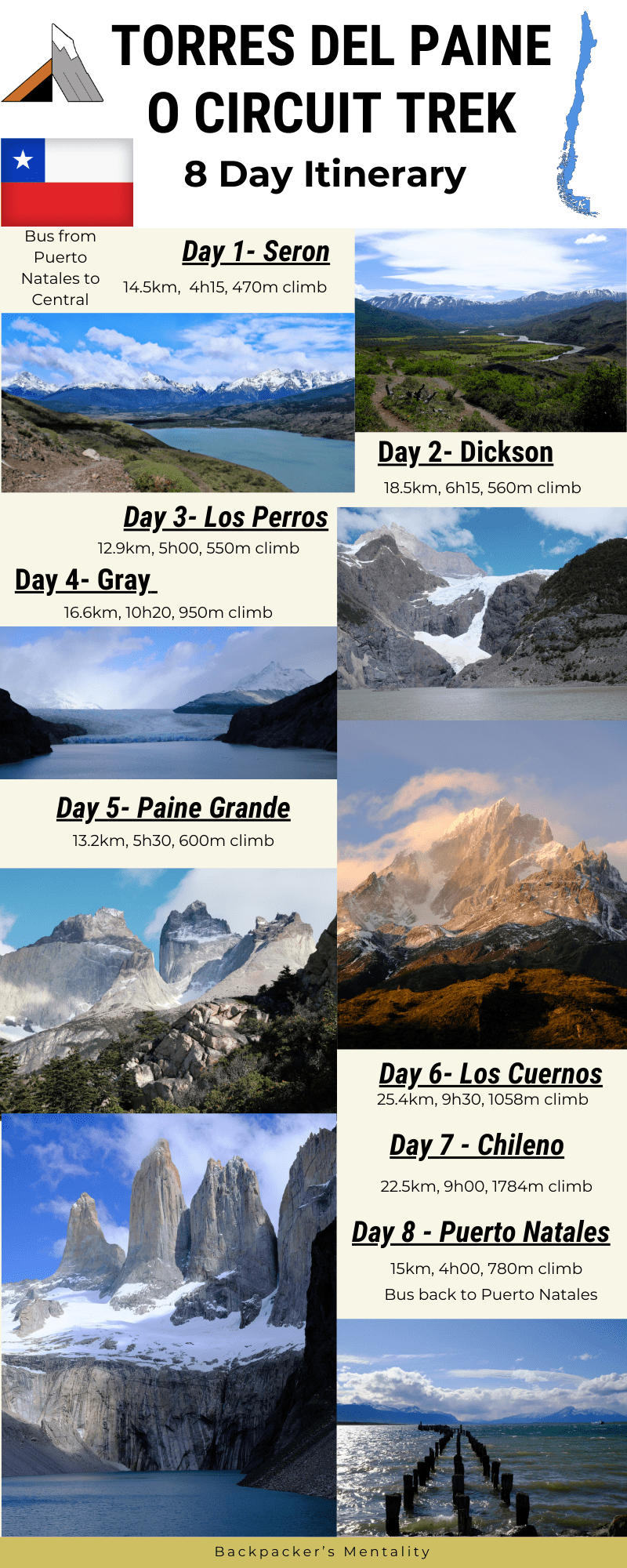
Why Torres del Paine & Patagonia?
After my first Solo Trekking experience on the Annapurna Circuit, I wanted a new challenge. The thought of camping in remote backcountry and trekking amongst beautiful Patagonian mountains seemed to fit the bill. Patagonia is known for its rugged terrain, challenging trails and unforgiving weather, famously the gale force winds battering the region from the southern tip of South America. Whilst El Chaletan in Argentina offered Fitz Roy and Cerro Torres (iconic mountains), for me, the striking Torres del Paine pillars at Mirador Base Torres are what attracted me most. The more I researched, the more excited I became about the challenge of solo travelling to Chile and Patagonia.
Torres del Paine (TDP for short) National Park is a recognised UNESCO Biosphere Reserve, highlighting it as one of the most beautiful places to visit. The imposing mountains, glaciers, rivers and turquoise lakes, along with the unique wildlife, make for a complete mountain adventure. The Park is 154km from Puerto Natales and has convenient transport links back to the town. It allows visitors to enjoy trekking, photography or hiking day trips in one of nature’s purest and most authentic regions.
Torres Del Paine O Circuit: Overview
The Torres Del Paine O Circuit is one of the world’s most iconic multi-day treks. It has even been included on the Lonely Planet‘s 10 Best Hikes in the World, especially for photographers. It offers a complete circumnavigation of the Cordillera del Paine (Paine Massif), combining the highlights of the shorter W Trek with remote backcountry trails, fewer crowds, and unparalleled views. The O Circuit (also called Paine Massif Circuit) is more remote than the W, requiring full commitment, proper planning, and reservations at designated campsites or refugios. The additional 34km adds 3 compulsory campsites (Seron, Dickson and Los Perros) and rewards trekkers with more untouched beauty and a chance to get off the grid with no internet for several days. This route is open from the 1st of November to April, compared to the W-Trek, which is open earlier and later in the season. Is the O Circuit worth it over the W Trek? If you have the time and fitness, then the O gives you solitude, more rugged and varied landscapes and a true wilderness feeling away from the crowds.
Torres Del Paine O Circuit Key Stats
- Length: 120 km / 74 miles
- Duration: 7–10 days
- Difficulty: Challenging
- Best Season: November–March
- Start/End Point: Central at the park entrance near Laguna Amarga or Hotel Las Torres
Total Trekking Stats
- Total Length: 139km
- Total Ascent: 6750m
- Total Duration: 36h33m
- Max Altitude: 1200m (John Gardener)
- Average Daily Distance: 17.4km
- Average Daily Ascent: 834m
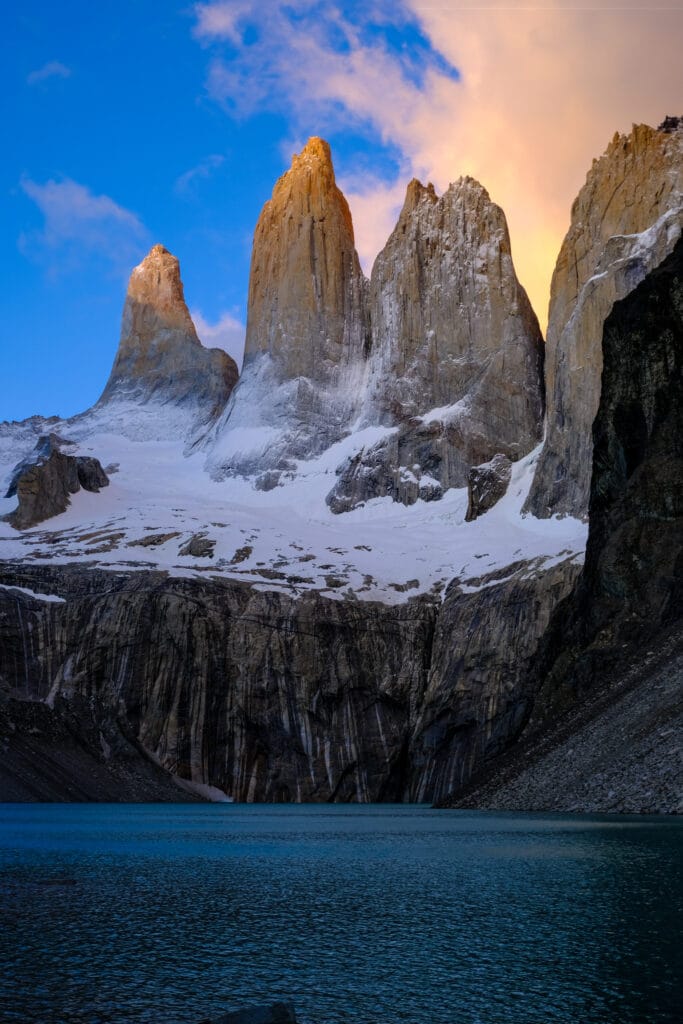
Torres del Paine O Circuit vs W Trek
| Feature | O Circuit | W Trek |
|---|---|---|
| Distance | 120 km / 74 mi | 74 km / 46 mi |
| Duration | 7–10 days | 4–5 days |
| Difficulty | Challenging | Moderate |
| Crowds | Much quieter, especially on the north side | Very popular and busy |
| Highlights | Includes all W highlights + John Gardner Pass, Grey Glacier, Dickson Lake, Los Perros | Torres del Paine towers, French Valley, Grey Glacier |
| Logistics | Requires more food, gear, and planning. It can only be trekked anti-clockwise. | Easier logistics, more refugios. It can be trekked in either direction. |
| Experience | True backcountry trek with solitude and adventure | More accessible, social, and structured |
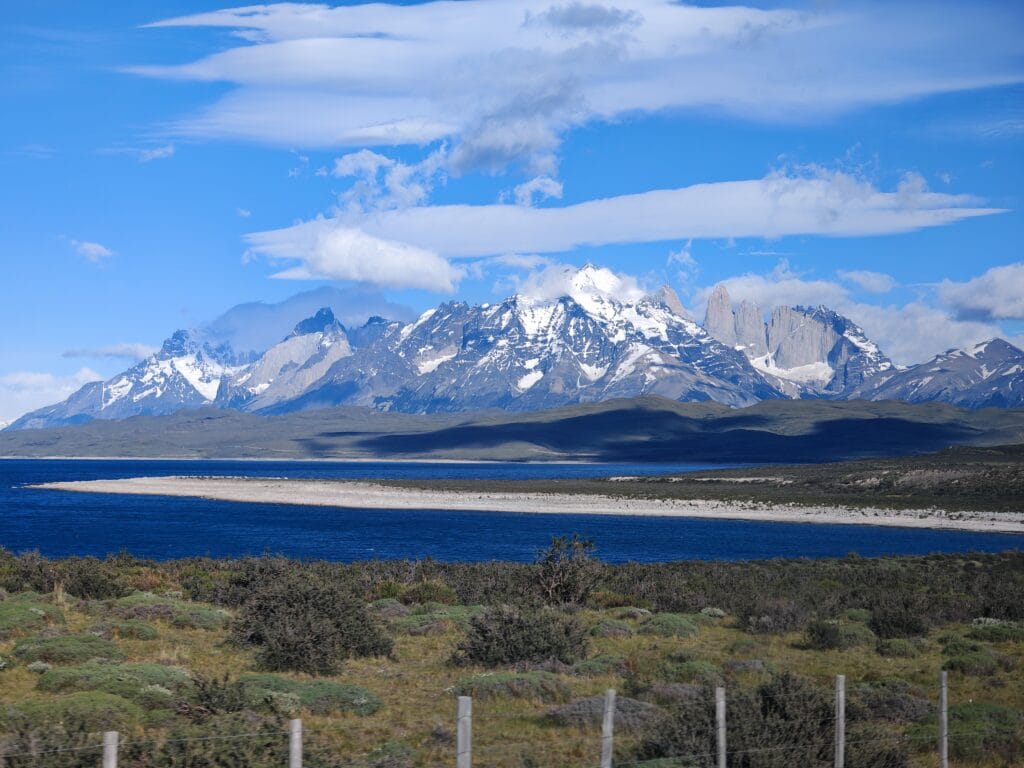
Torres del Paine O Circuit Highlights
Mirador Base Torres
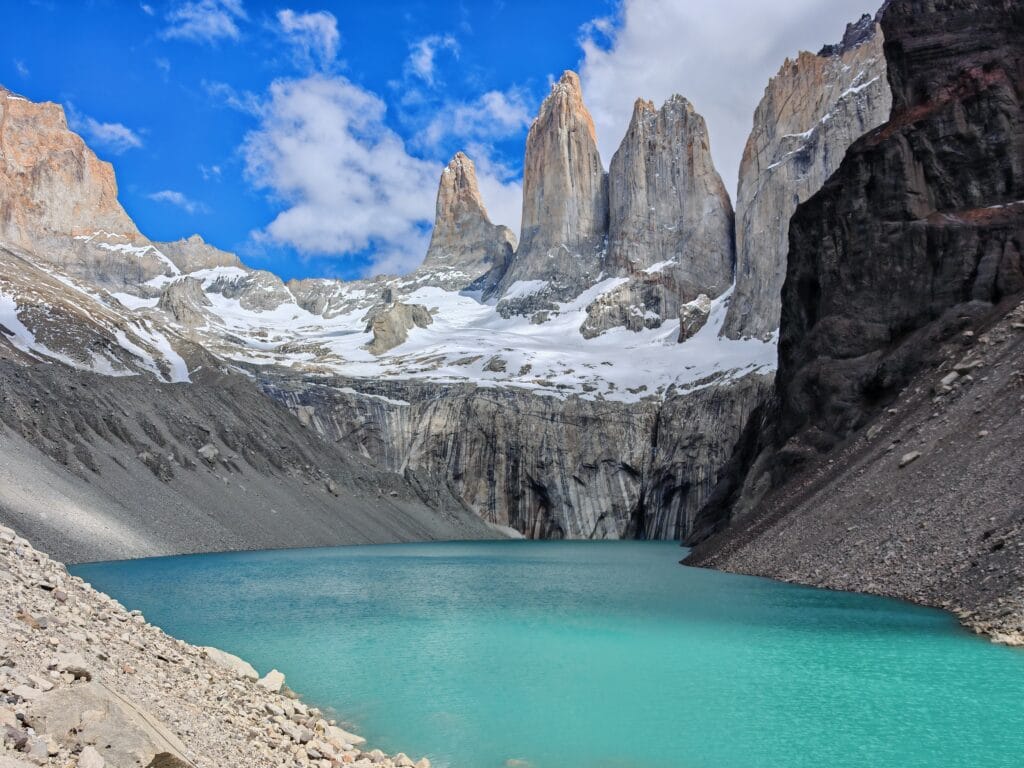
The main attraction is Mirador Base Torres, where the magical 3 towers loom over the aqua waters. And for the O circuit, what makes it more special is that after 7 days of long, hard trekking, you are rewarded with a memorable viewpoint. The hike up to Mirador Base Torres is by far the busiest day with many day hikers, W trekkers and a few O trekkers. Despite the hard scramble and crowds, the view is truly special, and if staying at Chileno campsite, then it’s worth doing the sunrise hike back to the towers.
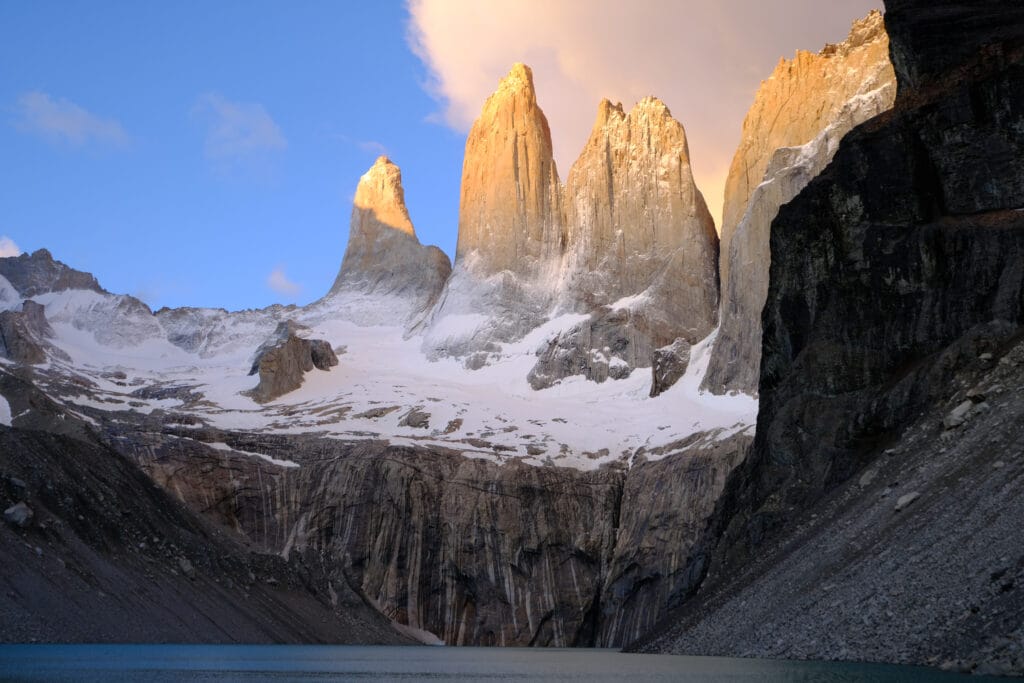
Mirador Britannico
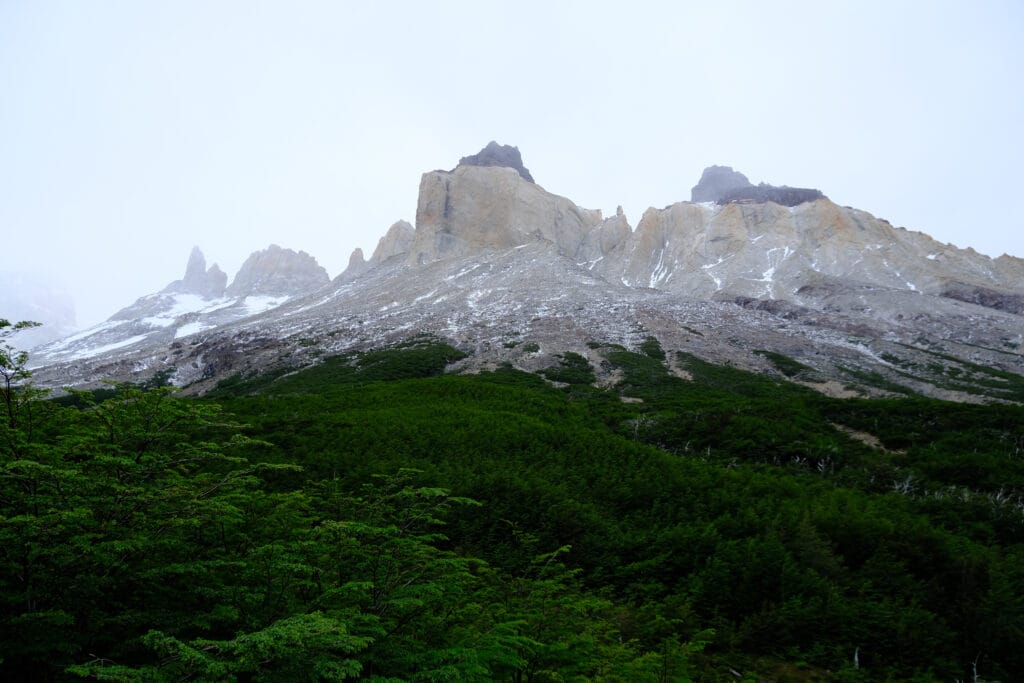
The W trek shape is defined by the 2 excursions to Base Mirador Torres and Mirador Britannico in French Valley. Mirador Britannico, on a good day, offers a great panoramic view of the mountains encompassing the viewpoint. The hike to the viewpoint is hard going, but passes via Mirador Francis, which is more impressive.
Los Cuernos
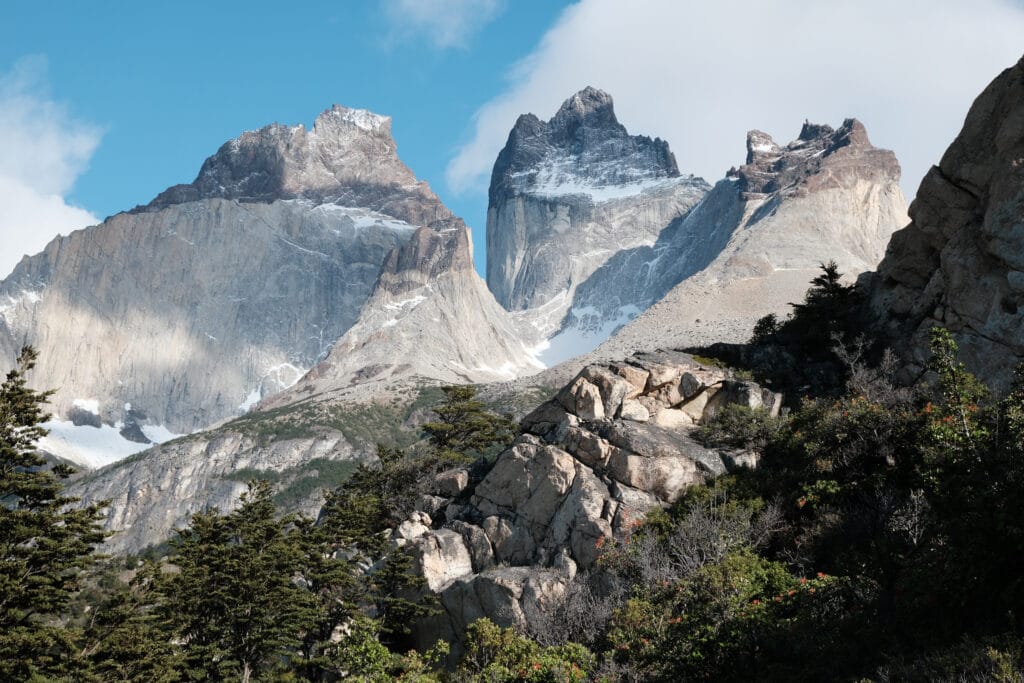
The second most iconic attraction in Torres Del Paine is Los Cuernos, the Bull Horns. Best seen from Mirador Cuernos, which is not on the W or O Treks, but staying at Los Cuernos campsite gives a great view still. The sheer vertical rocks with a gap in between represent the horns from afar. The trail up Frenches Valley also provides a great view of Los Cuernos, as well as from the Paine Grande campsite.
John Gardener Pass
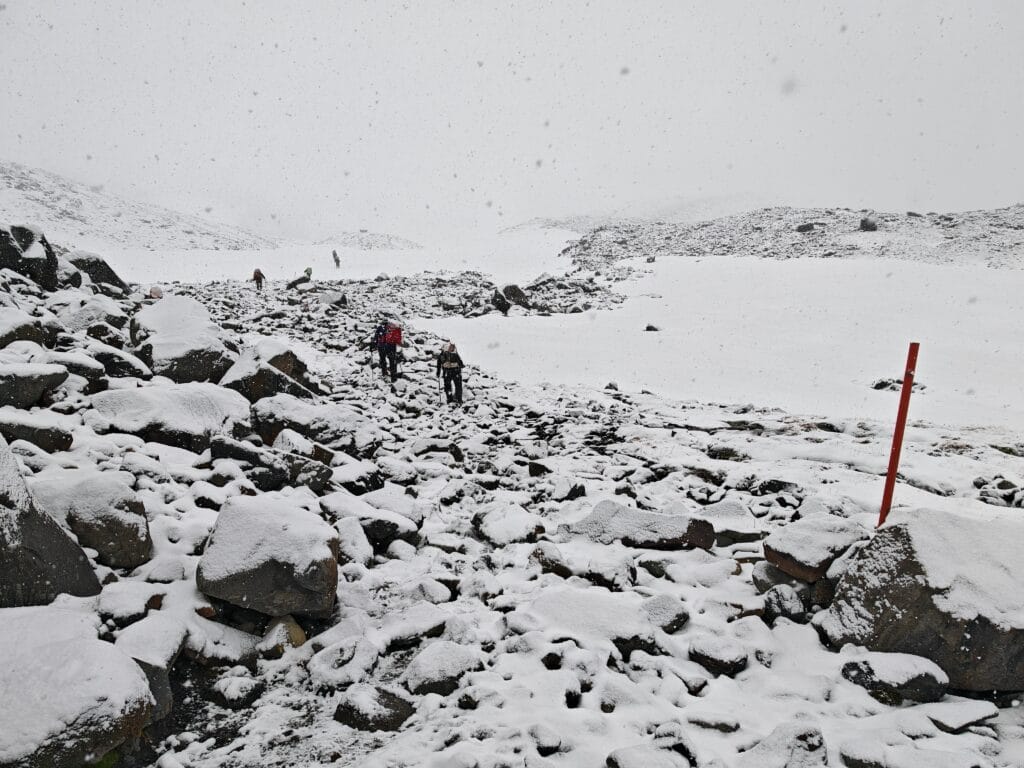
The Southern Patagonian Icefield is one of the highlights of the Torres del Paine O Circuit. The view from atop John Gardener Pass spreads across the valley with a glacial field spanning the valley. Instead of a great view, I was met with snow on the tricky ascent and clouds, but it’s also the highest point of the Circuit at 1200m. I was gutted not seeing the magnificent sight; it gives a great reason to return!
Grey Glacier
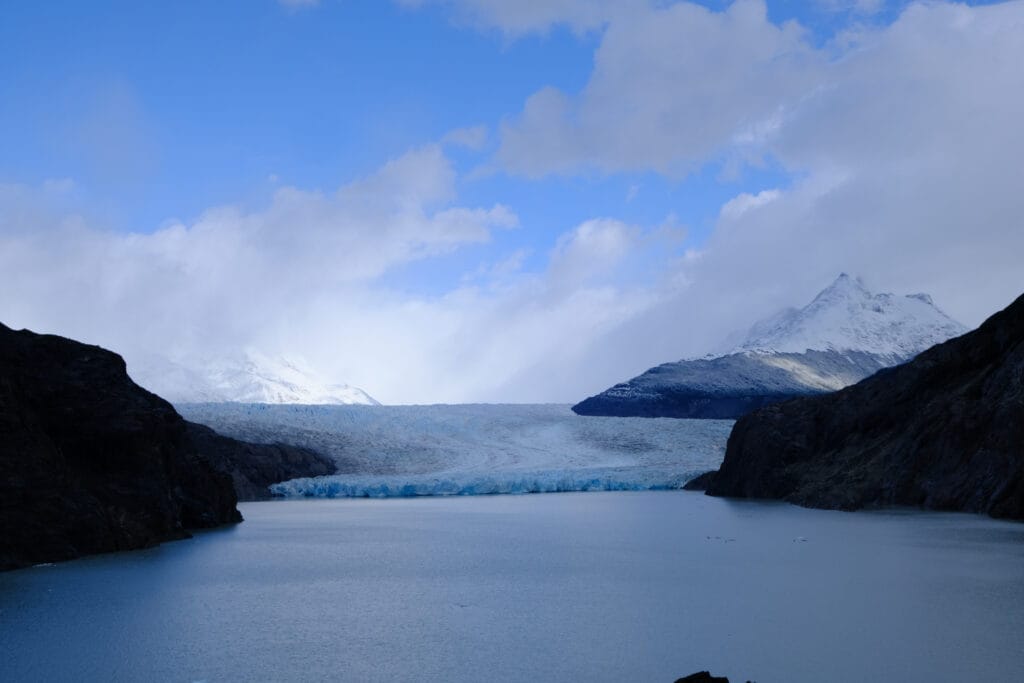
The end of the Southern Patagonian Icefield is Grey Glacier, with the Vertice Campsite near the Mirador Grey. It’s at Grey Glacier where the W trek begins, and the O Circuit joins the trekking route. The best view for W trekkers is from Mriador Grey. However, a perk of trekking the harder O Circuit is enjoying the views of the glacier for hours as you trek side by side.
Mirador Glacial Los Perros
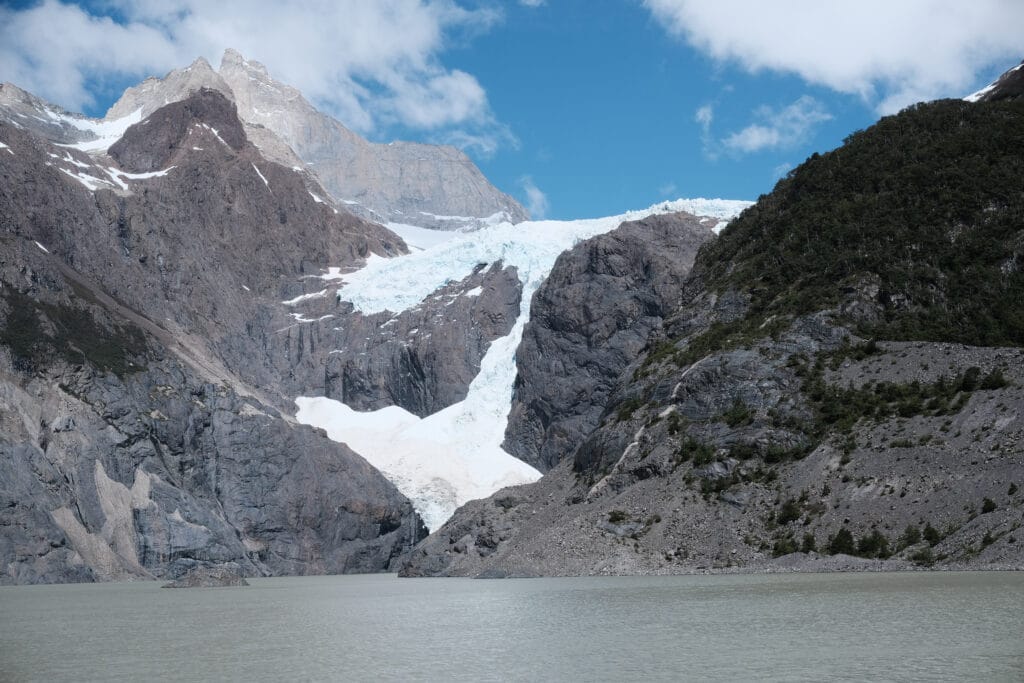
A treat for the O Trekkers on Day 3, the Los Perros Glacier hangs from the plateau above with a great Laguna below. This must-see sight is next to the Los Perros Campsite and makes for a good afternoon walk back to. It is the first of the proper Glaciers to see in Torres del Paine and has icy blue colours to enjoy.
Lago Paine
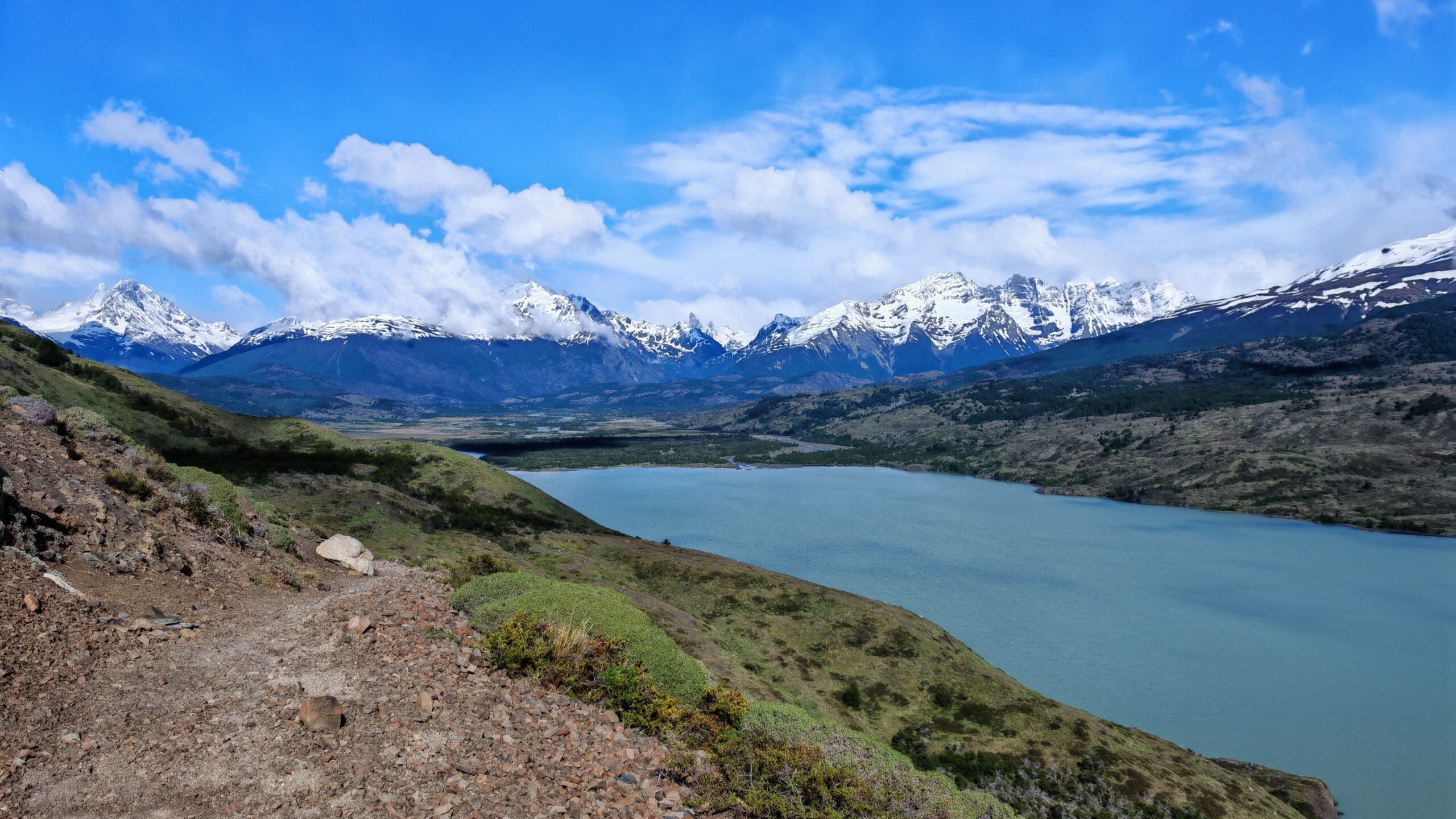
The first wow moment for me on the Torres del Paine O Circuit was at Lago Paine. The vast remote mountains in the distance and long Lago Paine below made for a great photo. For the next few hours, the view slowly changes as you hike closer to the epic snow-capped mountains near Dickson Campsite. This viewpoint, after the steep climb, is incredibly windy once finishing Sector Seron.
Dickson Lake
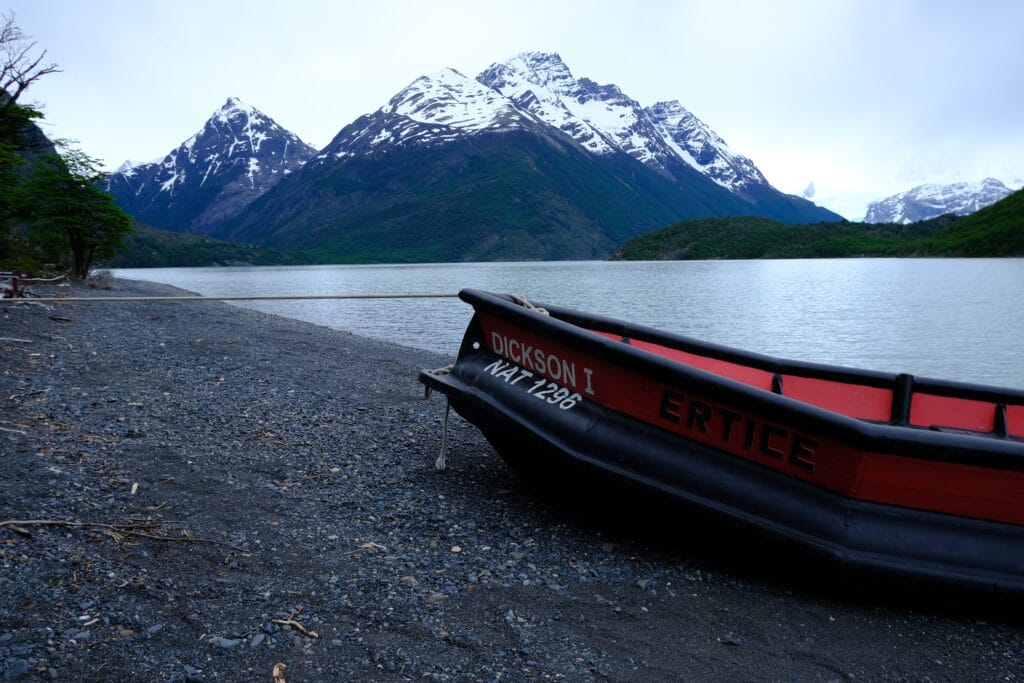
One of the nicest campsites on the O circuit is Dickson, located next to the great Lake Dickson. Which, in fact, flows from Argentina in the distance! It’s a peaceful campsite with a pebbly beach to explore and soak up the quiet nature surrounding the campsite.
Paine Grande
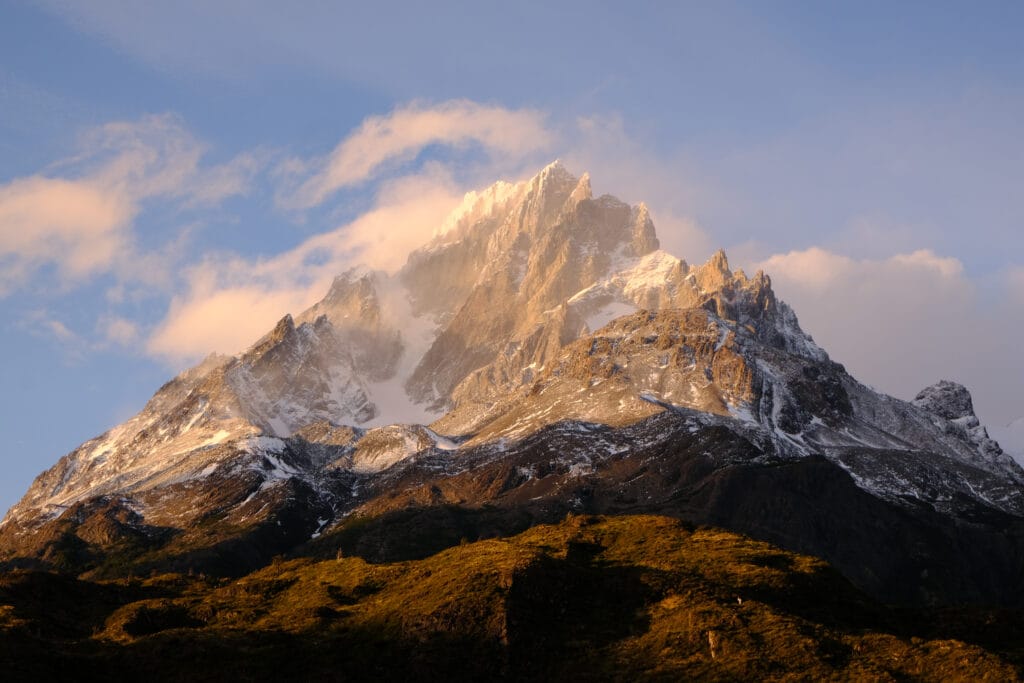
Once the O Circuit joins the W trek, the campsite facilities become much nicer, and Paine Grande had the best! With a ferry port nearby, it’s a popular place for trekkers to save money by going from Paine instead of Grey. The views are stunning, with Paine Grande seen in all its beauty and Los Cuernos in the distance.
Mirador Francis
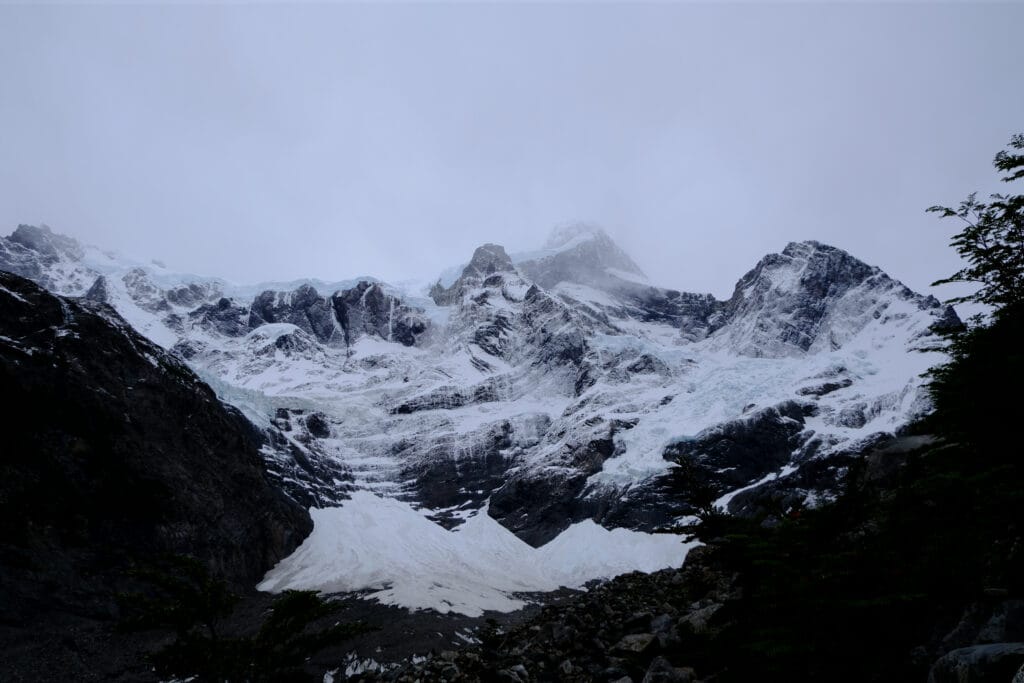
The underappreciated Mirador of French Valley is Francis, due to its proximity to the trail. Whereas, Britannico risks low cloud and hidden views. The spot is popular with hikers not wanting to push onto Britannico, but the vertical rock, ice and snow make for a formidable and daunting mountain. You can leave the heavy backpacks at Italiano Camp at the bottom of the valley before the climb up.
Puerto Natales
Even though this is not in Torres del Paine National Park, Puerto Natales is the central hub for people entering the park. With an airport and bus terminal, visitors will often spend the night before and after a trip to Torres del Paine in the small, charming town. With an impressive waterfront with a mountainous backdrop, there are many shops and restaurants. It’s easy to spend an afternoon in Puerto Natales grabbing last-minute supplies or souvenirs after a trek.
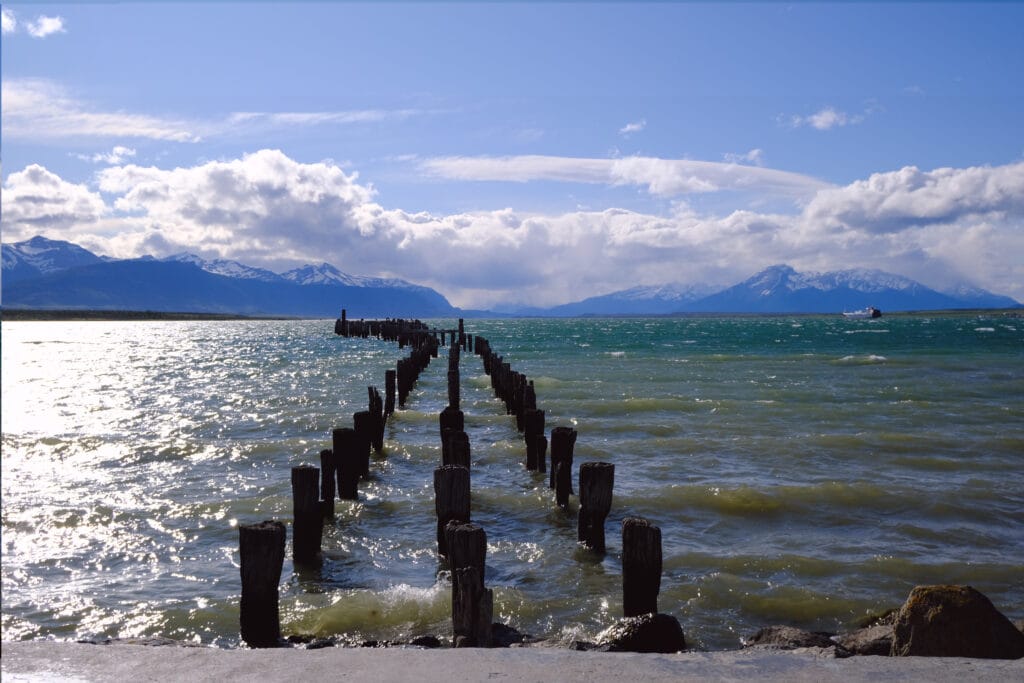
Torres Del Paine O Circuit Route Map
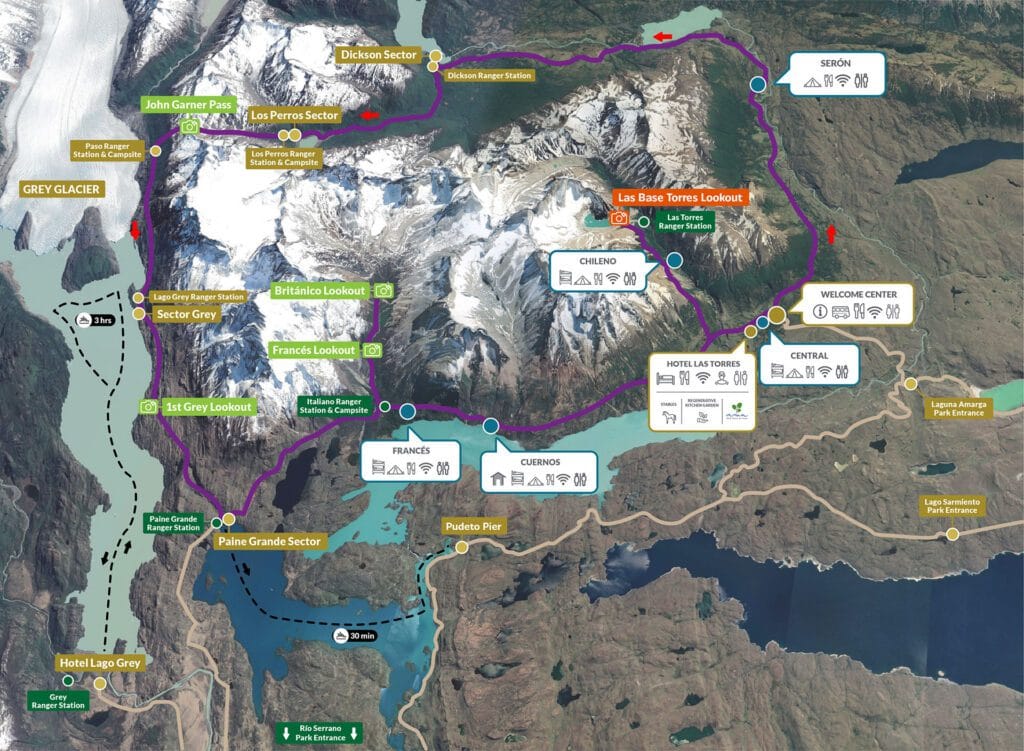
The Torres del Paine O Circuit differs from the W trek by having a mandatory direction of trekking. Additionally, there are 3 campsites that can’t be skipped either. Finally, there are only around 50 trekkers permitted to hike on each leg per day, which makes the trail much quieter. You can enjoy hours alone in stunning nature without any other humans. When compared to the W trek, which can have hundreds of people heading in both directions, it makes for a more peaceful and enjoyable trekking experience, in my opinion. The difficulty with the limited trekkers allowed is booking the campsites, which is covered later.
The O Circuit (Circuito O in Spanish) starts at Laguna Armarga/ Central, then heads to Serón first in a counter-clockwise direction. The next day is to Dickon and then Los Perros before tackling the John Gardener pass on Day 4, which ends at Grey. Now the O Circuit joins the W trek to Paine Grande. However, there are more options available over the next few days. On Day 6, it’s possible to stay at either Los Cuernos or Frances campsites. I would recommend Los Cuernos, but it’s a longer day from Paine Grande if hiking to Mirador Britannico as well. Then try to get a reservation at Chileno, as it allows the option for a sunrise hike to Mirador Base Torres over Central on Day 7. A tip is to start early each day as the strong winds pick up in the afternoon, and it’s wise to get a strategic camping spot.
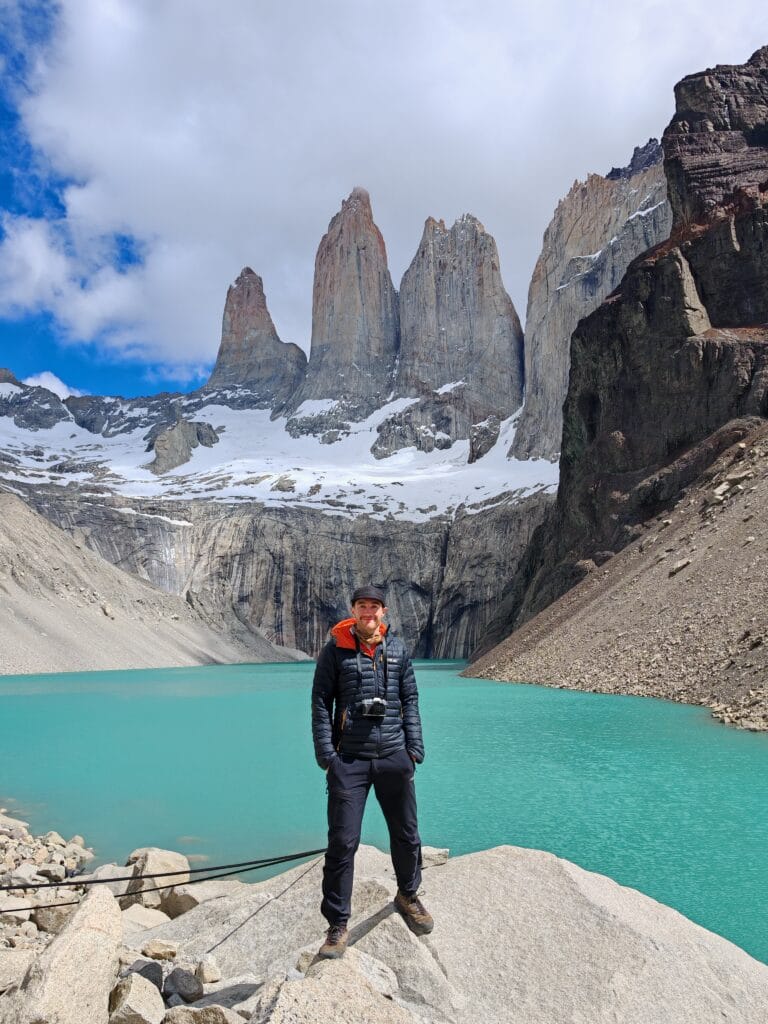
Torres del Paine O Circuit Planning
Transport
Torres Del Paine National Park is 129km from Puerto Natales, the most popular town to depart from. There is a small airport 7km from town with flights from Santiago (3 hours direct) operated by LATAM or SKY Airline. I would heavily recommend LATAM over SKY, as I had a positive experience and have heard SKY, despite being cheaper, has more complaints. Alternatively, you can fly 2hours to Puerto Montt (Chile), then 2 hours to Puerto Natales. The Santiago flights are twice a week, whereas the Puerto Montt flights are daily, so factor this in when booking flights and campsites. There are cheap taxis for $8000CLP (flat rate of $8.30) and an airport shuttle into the town for CLP 4,000 ($4). Otherwise, there are buses from El Calafate (Argentina) that arrive at the Bus Station to get to Puerto Natales before entering the National Park.
The bus from Puerto Natales to TDP National Park is operated by Bus-Sur, where tickets cost CLP$ 15.000 per journey. It’s best to book an early 7am bus departing from Puerto Natales Bus Station (Terminal Rodoviario) to give plenty of time for the journey and to start trekking. On the return journey, it’s possible to use Chileno or Central WiFi to transfer bus times to avoid waiting until 5-6pm and get an afternoon bus back to Puerto Natales instead. The first buses depart 6:45am to Laguna Amarga and take 2hours. From Laguna Amarga, there is a cheap Shuttle that can be pre-booked or paid upon arrival to take you from there to Central. No one skips he shuttle and does the extra few Km hike.
Campsite Reservations
The most difficult part of planning the Torres del Paine O Circuit trek is securing the campsite reservations! In summary, there are 2 companies which operate the campsites in the TDP National Park. Vertice Patagonia operate Dickson, Los Perros, Grey and Paine Grande. These campsites were much cheaper, thanks to the single tent pitch costing only $11-13 a night! In comparison, Las Torres operates Central, Seron, Frances, Los Cuernos and Chileno campsites. Las Torres campsites cost US$65 per spot, with the premium campsite at Chileno at $165. Both the W and O treks sell out quickly for high season, so book 4-6 months in advance to get your dates when the booking systems open around May.
The hard part is that the booking systems open at different times, which makes organising flights and dates tricky. Luckily, there is a fantastic website called TorresHike, which acts as a middle person. The O Circuit is very popular, especially in December and January; therefore, it’s best to book as soon as possible. TorresHike allows you to choose the dates, accommodation and meals in an easy booking system. In 2024, the campsites opened in June time around 4 months before the trek started. Both Las Torres and Vertice were rolling out new booking systems, hence there were limited dates last year. If booking on your own, then check both travel agencies for availability and double-check that the dates align. There is a strict No Wild Camping policy, so you must stay at the designated campsites in TDP. You need the camping reservations printed off or available to check in at every campsite upon arrival.
Puerto Natales Accommodation
Puerto Natales is a hub for backpackers, hikers and outdoor lovers coming and going to Torres del Paine. There is a wide variety of accommodations in the town, with budget options to high-end hotels. I used HostelWorld to book 2 different hostels before and after the trek. First, I stayed at the highly rated and popular Hostel Last Hope, where Diego is a great host, and it was easy to get tips from other trekkers before going to the Park. The rooms were 4-bed bunks costing only USD$13 a night! After the O Circuit, I stayed at Yaganhouse Hostel (dorms for $24 per night), which was much quieter with a fantastic breakfast and much-needed hot showers.
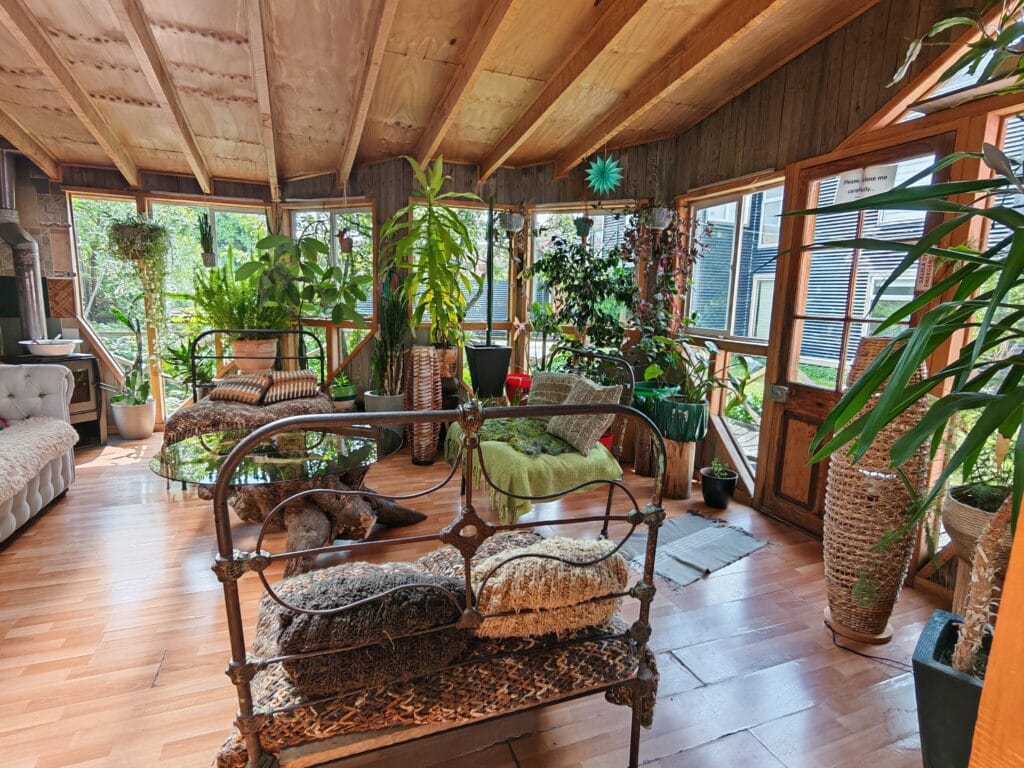
Permits
Torres Del Paine National Park requires a park entrance ticket to enter. The 3 entrance points where tickets are checked are Laguna Amarga, Laguna Sarmiento, and Serrano, with most people arriving through Laguna Amarga. The tickets issued by CONAF must be booked in advance using this Park Tickets link. The tickets cost from $32,400 CLP for a foreign adult ticket up to 3 days (for day hikes), but for the O Circuit, a foreign adult ticket for over 3 days is required, costing $46,200 CLP (USD $49 / £36).
Season & Weather
The TDP National Park is usually open from the 1st of October to April, which is the equivalent of Spring through summer to Autumn. The southern hemisphere seasons mean you can enjoy Christmas trekking around Patagonia! The shoulder season is cheaper and quieter, with better wildlife spotting opportunities yet trickier weather. The O Circuit officially opens on November 1st at Seron, then Dickson and Los Perros opening the next days. I started my epic trek on the 2nd of November, so I was one of the first groups of the season to complete the Paine Massif Circuit. Whilst some of my dates were dictated by availability and costs, the early season meant I experienced all the weather Patagonia had to offer. Be prepared for sun, rain and snow throughout the trekking season, even in summer.
The geography of Patagonia, being at the southern tip of South America, means it is battered with strong winds travelling around the continent between Antarctica. The winds are famous and can exceed 120km/h (74mph), which will knock you off your feet when hiking! The worst days were near Lago Paine, the approach to Paine Grande and hiking alongside Lake Nordenskjöld. Some advice for tent pitching: always pick a sheltered spot for protection. I had my Big Agnes Copper Spur Tent tested with over 60mph winds at night, forcing me to pack away in pitch black and set up in the forest. Some days had lovely sunny weather, whereas other days had low cloud blocking the views. The worst day for weather for me was also the hardest going over John Gardner Pass, where a snowstorm had happened the night before. This meant no views of the Southern Patagonia Icefield, and instead, battling with deep snow and slippery surfaces.
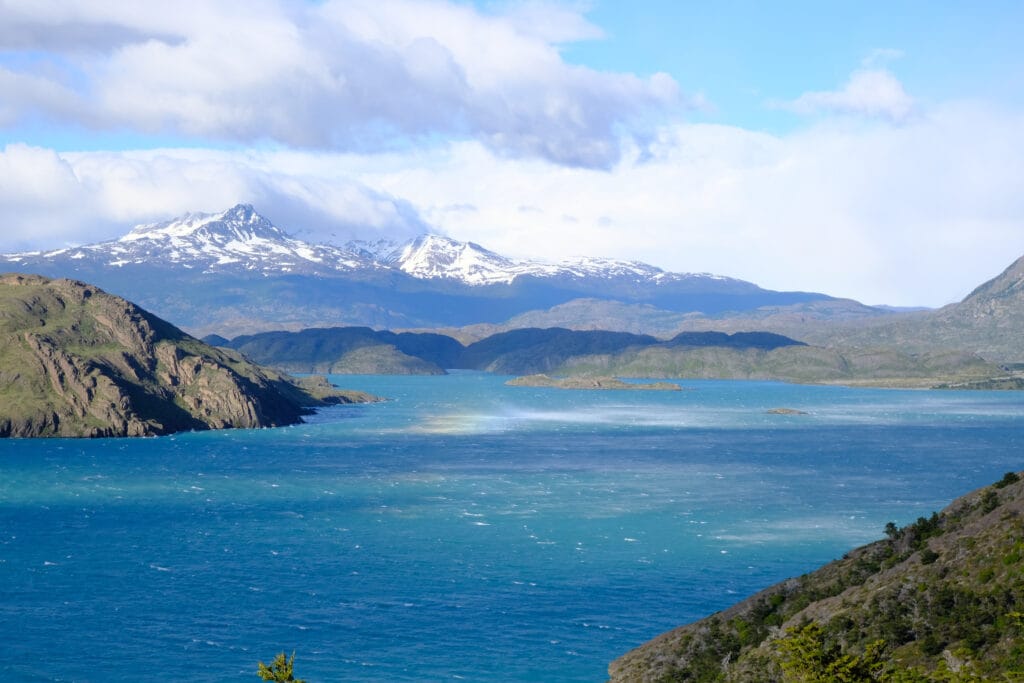
Fitness & Difficulty
The Torres Del Paine O Circuit trek is a challenging hike compared to most due to the remote nature and unpredictable weather. Whilst it might not have the altitude of a Himalayan trek or the climbing required in the Dolomites, Patagonia still requires good fitness due to the camping style. The O Circuit took me 8 days of consecutive hiking on varied terrains whilst carrying an 18kg Osprey Atmos Backpack. The O Circuit requires camping, so the weight of a tent, sleeping bag on top of clothes and snacks adds up. Therefore, you should be able to hike up to 25km and over 1000m of climbing whilst carrying a 15kg pack as trekking preparation. Regular hiking and camping experience beforehand will make it more enjoyable than testing unfamiliar camping equipment out when on the trek. The hardest day is the John Gardener Pass with a very steep climb, exposed to strong winds and weather prone to snow and rain (see pics above).
Navigation
The O Circuit trail is very well marked with signposts at each Sector. It doesn’t give distances or times between campsites on the signs, but there are maps around the Park showing these hiking stats. Despite its remote nature with a lack of phone signal or internet, it’s hard to get lost in the park with so many trekkers, especially on the W Trek sections. A Map or GPS is useful but not crucial in my opinion. The hardest day is over the John Gardener Pass, where poor weather and snow can make navigation more difficult. Also, it’s best to be prepared for long days between Seron to Dickson, John Gardener Pass and the days hiking up to Mirador Base Torres and Mirador Britannico.
Equipment and Kit List
For the Patagonia Trek, I used my Trekking Packing List from my Annapurna Circuit Trek. Then replaced the cold-weather gear with additional camping gear from this Camping Packing List. The heaviest weight was my Big Agnes Copper Spur tent; however, this did exceptionally well against the strong winds, whereas other cheaper tents broke and bent. As with any trek over rugged mountains, it’s best to invest in lightweight good good-quality equipment to avoid a heavy backpack. In particular with Patagonia, the variable weather meant I needed my Arc’teryx Beta AR Waterproof often, as well as Down Jackets and other layers when snowing or around camp. Trekking poles are definitely helpful on the John Gardener Pass and venturing to Mirador Base Torres & Britannico. It’s worth noting, there is no phone signal in the park, but I used an e-SIM in Santiago and Puerto Natales for internet to help with navigation and finding food spots.
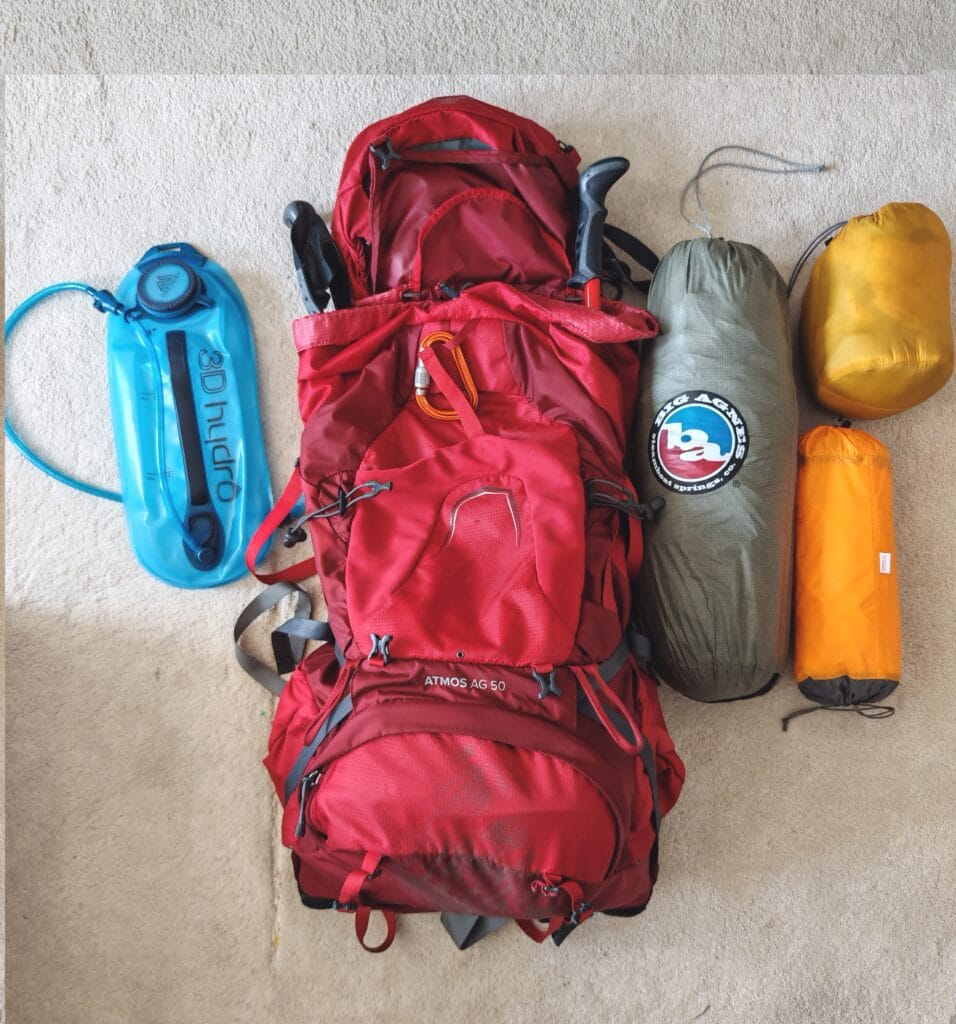
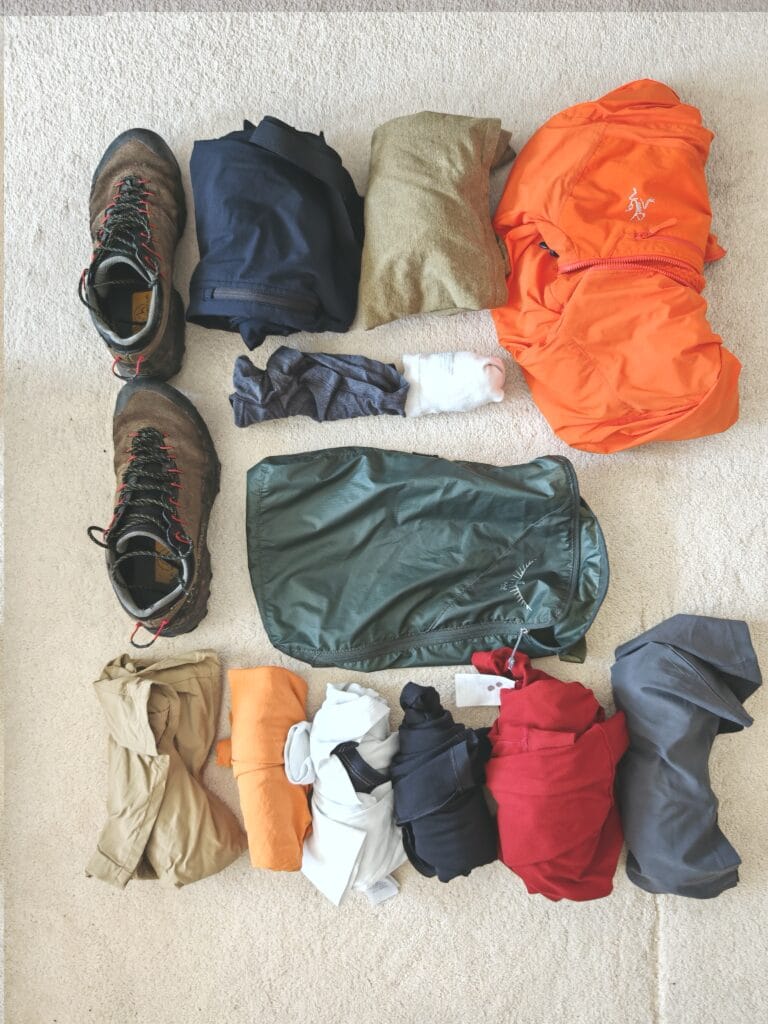
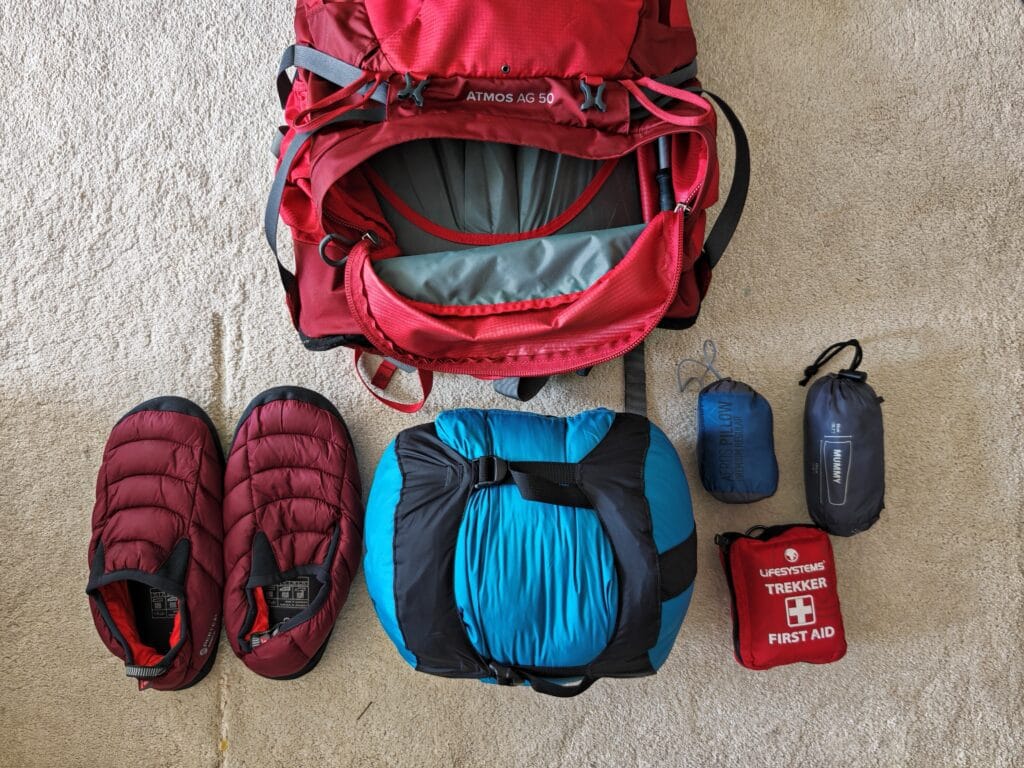
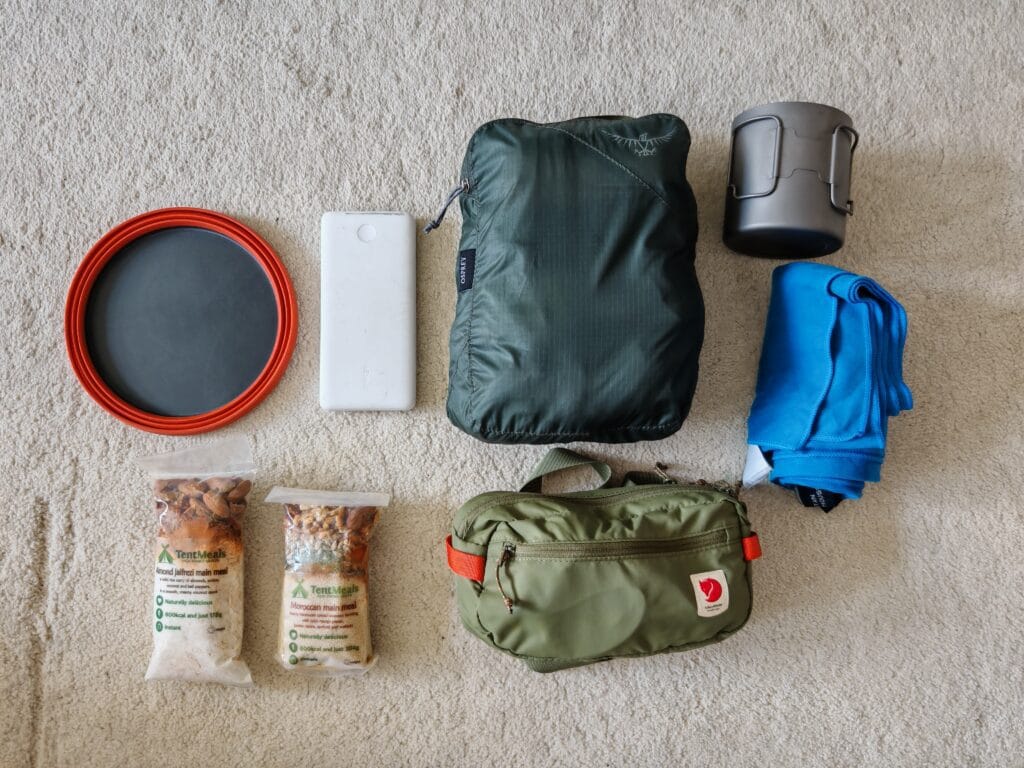
Food & Water
Torres Del Paine is one of the few places where the streams and river water is drinkable. It’s fresh mountain water where a filter isn’t needed, but good to take out any debris! Every campsite has taps to easily fill up water to stay hydrated in each sector of the trek. When trekking for 8 days, carrying enough food for every meal over the entirety can add serious weight. Whilst most trekkers did bring food and cooked in the communal kitchen, I opted to pay for meals at most of the campsites (apart from Seron and Los Perros, where I used dehydrated meals and borrowed a stove to boil water). I figured I saved easily 4kg of backpack weight by outsourcing the catering; however, next time I’m keen to save money and cook. It’s easier to bring food and cooking equipment when backpacking in a group or couple compared to solo trekking, which I did.
The campsites often have a small kiosk to pick up snacks, but they are limited and expensive, which is to be expected in remote backcountry campsites. The W Trek campsites, in general, had larger catering options to accommodate the higher number of trekkers compared to the O Circuit only campsites. Whilst the full-board options were pricier, the quality of food was excellent and very filling after a long day’s trekking. The dinners were 3-course meals, and the breakfast was a buffet option to fuel for the day. Then the box lunches surprised me most with healthy sandwiches and snacks. It’s worth going to the supermarket in Puerto Natales to bring some extra snacks along for the long trek.
Language & Money
In TDP, the local Chilean residents will pay a lower price in Chilean Peso, whereas foreign visitors often pay a higher rate. The local currency is CLP, with US Dollars (USD$) prices often shown. The dollar rate is only valid when you present a valid park entrance and passport when checking into camp. There are no ATMs in the park, so be sure to exchange in Puerto Natales beforehand. However, some campsites accept cards to pay for WiFi, drinks, food and other things. The local language of Chile is Spanish, but most people speak some English. It’s worth practising some basic phrases and downloading Spanish offline on Google Translate.
Guided vs Unguided
It’s not required to have a guide to trek the O Circuit or W Trek. Most of my fellow O Trekkers were independently trekking, with only 1 person having a guide. I did look at the guided option; however, the costs were almost double. The trek is safe, easy to naviagte and fairly simple to book (with TorresHike), so a guide is not needed to hike around Cordillera del Paine.
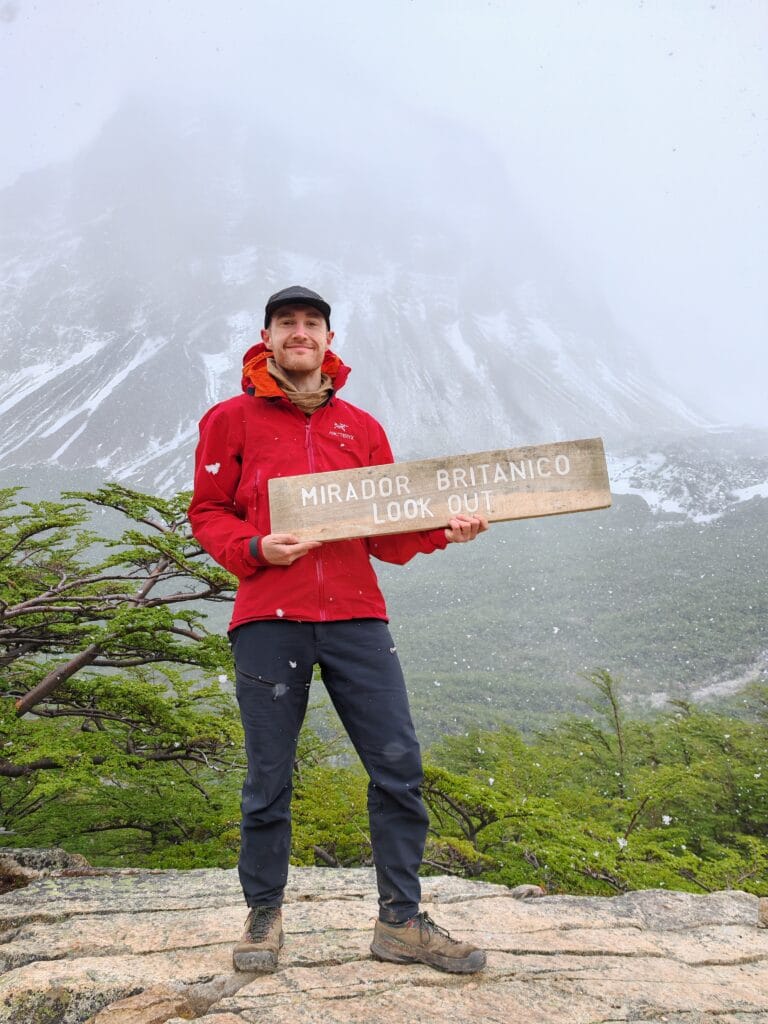
Torres Del Paine O Circuit Campsites
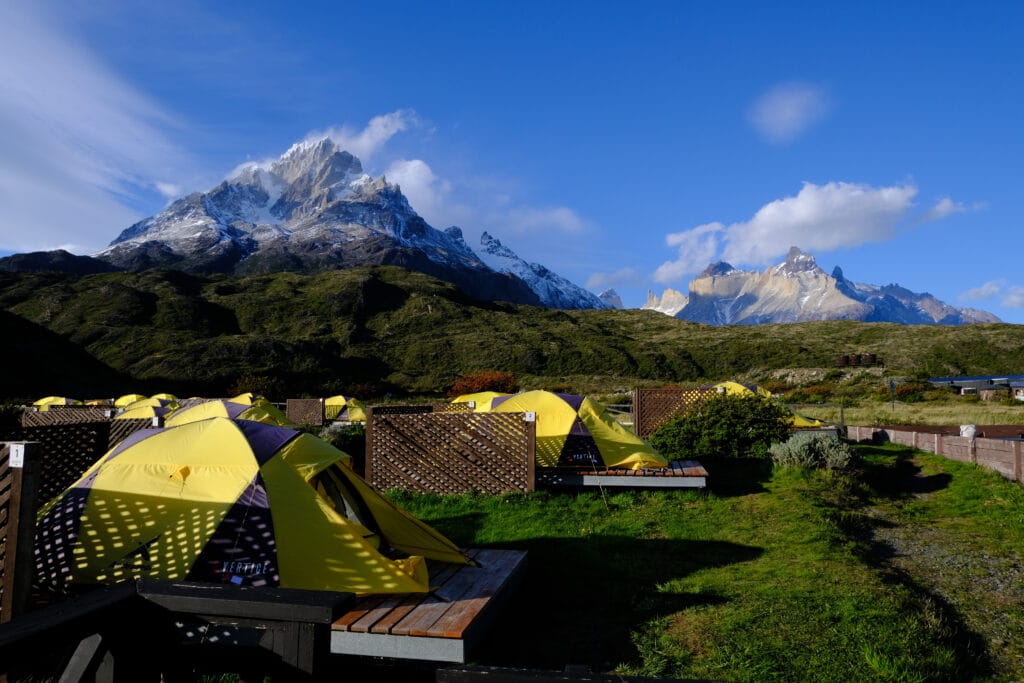
Torres del Paine is best experienced by camping, as the landscape is so beautiful, and what better way to connect than sleeping under the stars. By carrying your backpack between each campsite, it feels like an epic journey through the Patagonian mountains. Trekking the O Circuit is a fantastic way to escape to nature and disconnect from the outside world. The biggest daily challenge is finding a good spot to pitch a tent! The campsites are very well run and offer all the essentials for trekkers each night. With various accommodation types and food options, it’s easy to customise your itinerary to suit your preferred style and budget.
Vertice Patagonia and Las Torres operate the campsites throughout the TDP National Park, where the remote sections (Dickson, Los Perros and Seron) offer more limited facilities. It’s worth bringing Chilean Pesos for the shuttles and in case you want anything at the campsites bar/shop/restaurants. In my honest opinion, Las Torres overcharges for the price of the individual campsites and costs more overall than Vertice. Plus, Vertice Patagonia was the best campsite of Dickson and Grey compared to Chileno, Seron and Los Cuernos (Can’t talk for Frances or Central). All the prices below are accurate for the 2025-26 season, which has increased marginally compared to the prices in 2024.
Las Torres Campsites
- Serón – This campsite is the O Circuit starting point and is situated 4 hours from Central. The campsite offers great mountain views after passing ancient lenga forests and rivers. Serón only offers camping along with a dining room, WiFi, and bathrooms with hot showers. The camping is on a grass field where people pitched around the perimeter.
- Francés – Located near the base of the Francés Valley, the camp is nestled in the trees to get protection from the “foehn” winds. I didn’t stay at Frances, but as it’s on the W Trek, it offers WiFi, dining options and hot showers. Like Los Cuernos, the surrounding landscapes of Lake Nordenskjöld, Cerro Paine Grande, Cerro Ferrier and Mt. Tenerife are majestic.
- Los Cuernos – The views back to Paine Grande and over Lake Nordenskjöld are wonderful. With Los Cuernos mountain looming, this large campsite has wooden camping platforms in the trees and on the hill. My advice: choose a pitch in the protected trees. There are bathrooms with hot showers and a very good restaurant.
- Chileno – Perfect for a sunrise hike to the famous Las Torres Mountains. Chileno doesn’t allow individual tent pitches, so you have to stay in the expensive pre-pitched tents. There are hot showers and toilets with a busy bar and restaurant. Chileno is popular with day hikers, and it’s possible to leave your backpack while climbing to Mirador Base Torres. A free welcome drink voucher is a bonus too!
- Central – Not as many people stay at Central unless they can’t get a reservation at Chileno. It’s a well-stocked campsite with WiFi and all the normal facilities. It’s close to the shuttles and buses for convenience.
Las Torres Services
- Fully Equipped Camp: a pre-pitched 2-person tent elevated from the ground with all the camping equipment (tent, sleeping bag, mat, pillow) for a great night’s sleep. High Season (November 2025 to March 2026) costs USD $150 per person, then USD $140 p/p in October and April (shoulder seasons) based on double occupancy. If a solo traveller, then it’ over $250 for these luxury options.
- Semi-Equipped Camp: The same elevated 2-person pitched tent and high-density foam mattress, but no pillows or sleeping bags included. The bathrooms and showers are shared with fellow campers. For a double occupant, the price is USD $110 p/p in high season and $105 in shoulder, with almost double for single person occupancy.
- Individual Camp: My preferred option was to find a spare campsite and pitch my own tent on the ground or wooden platforms. The bathroom facilities with hot showers are close by. This is the much cheaper option, costing up to USD $ 60 per person for 2 people or $90 for a single occupant in high season.
- Mountain Hostel / Refuge: Lodging Rates to stay in a single bed in a shared dorm room are USD $207 p/p in high season and $185 in October and April. Available at Frances, Central and Cuernos, where Mountain Cabins are possible for USD $320 (Based on double occupancy).
- Meal Plans: Las Torres offers these meal options to save carrying all your food for over a week. These options have limited capacity, so book early if you want them! Full board (breakfast, box lunch and dinner) costs $130, and half board (breakfast and dinner) costs $90. Individual meals cost $35 for breakfast, $40 for a box lunch and $65 for dinner. So in comparison, the full board would save $10 per day.
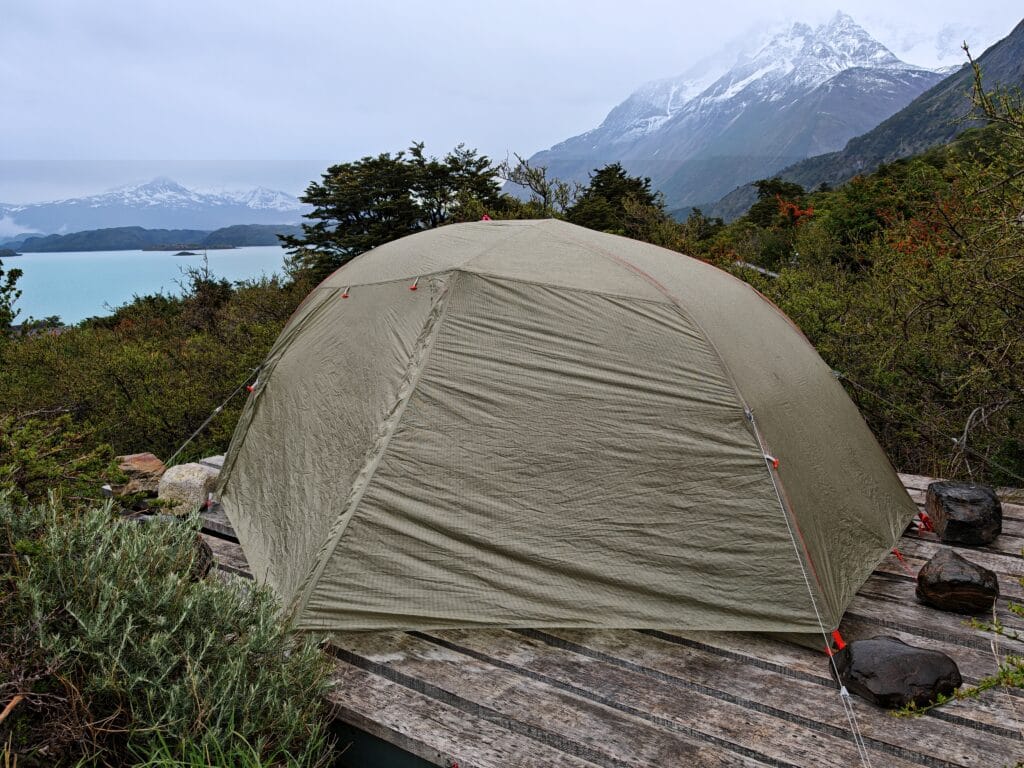
Vertice Patagonia Campsites
- Dickson – Located on the edge of Lake Dickson, there are wonderful views of the glacier on the Argentinean border, Tridente, Escudo, Cabeza del Indio, and Los Gemelos mountains. This is the northernmost sector of TDP National Park and the second most remote after Los Perros. There is no internet and limited electricity available, so bring a powerbank and use Aeroplane mode! However, there is a small kiosk, a refugio (dorm accommodation) and a very good restaurant!
- Los Perros – Located deep and amongst a sea of lenga and coigüe trees, Los Perros is one of the most remote spots on the Paine Massif Circuit. It’s the last camp before tackling the challenging John Gardner Pass (1,200 meters above sea level). As expected, there is no internet or hot water (feel free to take a cold shower). There is only camping available with some very basic items from a shop if you’re desperate.
- Grey – It is the closest camp to Grey Glacier and the starting point for the W Trek. It offers glacial hiking, kayaking and hiking to views of Campos de Hielo Sur (Southern Patagonian Icefield). It’s the next campsite after passing the John Gardner Pass, so a perfect place for a hot shower, food and beer after a tough day.
- Paine Grande – Located on the shores of Lake Pehoé, it is the busiest refuge and campsite. With long queues to check in and a popular buffet dinner (instead of table service), it’s a shock to the system after the remoteness of the northern sectors. The beautiful views of the Cuernos del Paine and the Paine Grande hill are impressive at sunset. Paine Grande has hot showers, a separate bar, WiFi, lounges and the option for a boat after finishing the W Trek.
Vertice Patagonia Services
- Pre-Pitched Camp: Unlike Las Torres with the elevated tents, Vertice Patagonia offers bright yellow 4-season pre-pitched tents (maximum 2 persons) for $44 USD per night. These have the same facilities of showers (hot water not guaranteed), a kiosk and bathrooms at most campgrounds. With WiFi and full food catering being available at certain campsites mentioned above.
- Individual Camp: Pitching your own tent with Vertice was the cheapest option by far! The campsite only costs $12 USD per a per per night, which is a great value compared to $60 at Las Torres. Vertice offered camping equipment rentals of cold-weather sleeping bags ($46 per night) and foam mattresses for $29 per night.
- Mountain Hostel / Refuge: Lodging Rates to stay in a single bed in a shared dorm room are USD $43 p/p for a single bed. For a double bed (full bed), it costs $105 USD, which is half the price of Las Torres! This option is only available at Paine Grande, Grey and Dickson (sorry Los Perros).
- Meal Plans: Vertice also offers these meal options to save carrying all your food for over a week. These options have limited capacity, so book early if you want them! Full board (breakfast, box lunch and dinner) costs $100, and half board (breakfast and dinner) costs $68. Individual meals cost $30 for breakfast, $32 for a box lunch and $48 for dinner. So in comparison, the full board would save $10 per day and is $30 a day cheaper than Las Torres.
Torres del Paine O Circuit Campsite Ratings
| Campsites | Food & Drink | Facilities | Location | Value | Total |
| Seron | 6 | 8 | 8 | 6 | 6.5 |
| Dickson | 8 | 6 | 9 | 10 | 8.3 |
| Los Perros | 5 | 4 | 5 | 8 | 5.5 |
| Grey | 7 | 9 | 7 | 10 | 8.3 |
| Paine Grande | 7 | 8 | 7 | 9 | 7.8 |
| Los Cuernos | 9 | 8 | 7 | 6 | 7.5 |
| Chileno | 8 | 9 | 8 | 4 | 7.3 |
The best campsite overall was a tie between Grey and Dickson, both scoring an 8.3/10. Remember that the W-Trek has better facilities naturally, as it has more trekkers and easier supplies. So the winner has to go to Dickson, given the remote location in the North of Torres del Paine. It had the best location, views and also the best food!
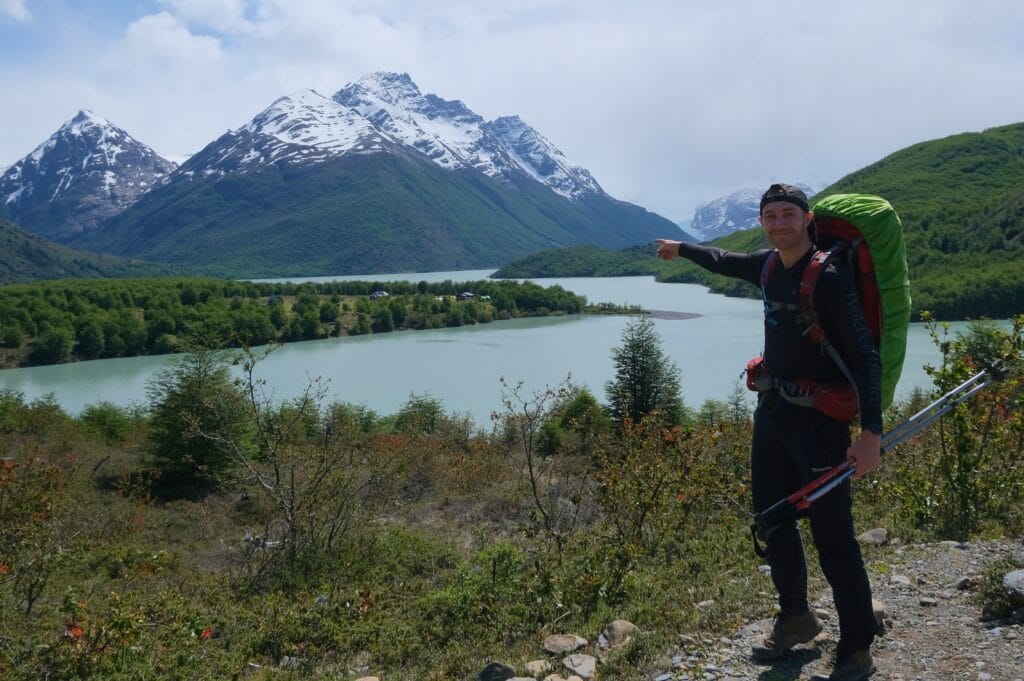
Torres Del Paine O Circuit Trip Budget
Unfortunately, this trip to Patagonia was never going to be cheap to start with, given the flights from London Heathrow to Santiago, Chile, costing £1100 return. There are multiple ways to save money or enjoy more luxury in Torres del Paine. The campsites have options to pitch your own tent, rent a pre-pitched tent or stay in a dorm style (most expensive). Then, you can opt for half-board (my choice) for 3 meals a day, including a packed lunch to take, which saves carrying 8 days’ worth of food around the trek. And then at the well-stocked and W trek campsites, WiFi can be purchased (at an extortionate price) as well as alcohol for a more reasonable cost. Some fixed costs are unavoidable, such as the National Park Entrance Fee and the Buses & SHuttles to reach the start of the O Circuit. But luckily, Puerto Natales has plenty of accommodation and restaurants for different budgets.
| Item | Cost (£) | Cost (US$) |
| Flights | £1550 | $2095 |
| Torres del Paine Buses & Shuttle | £45 | $61 |
| Campsites | £279 | $377 |
| Campsite Food | £407 | $550 |
| Hostels & Hotels | £170 | $230 |
| Park Entrance Ticket | £36 | $49 |
| Restaurants | £100 | $135 |
| Others (Souvenirs, Taxis etc) | £150 | $203 |
| Sub Total | £2687 | $3700 |
Torres Del Paine O Circuit Artwork
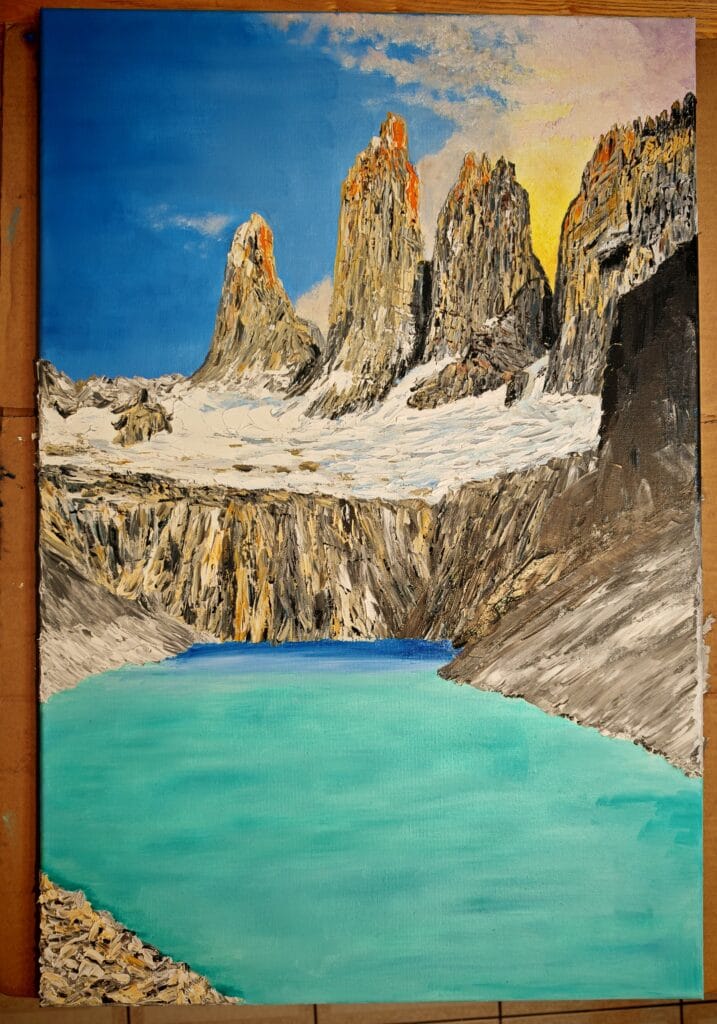
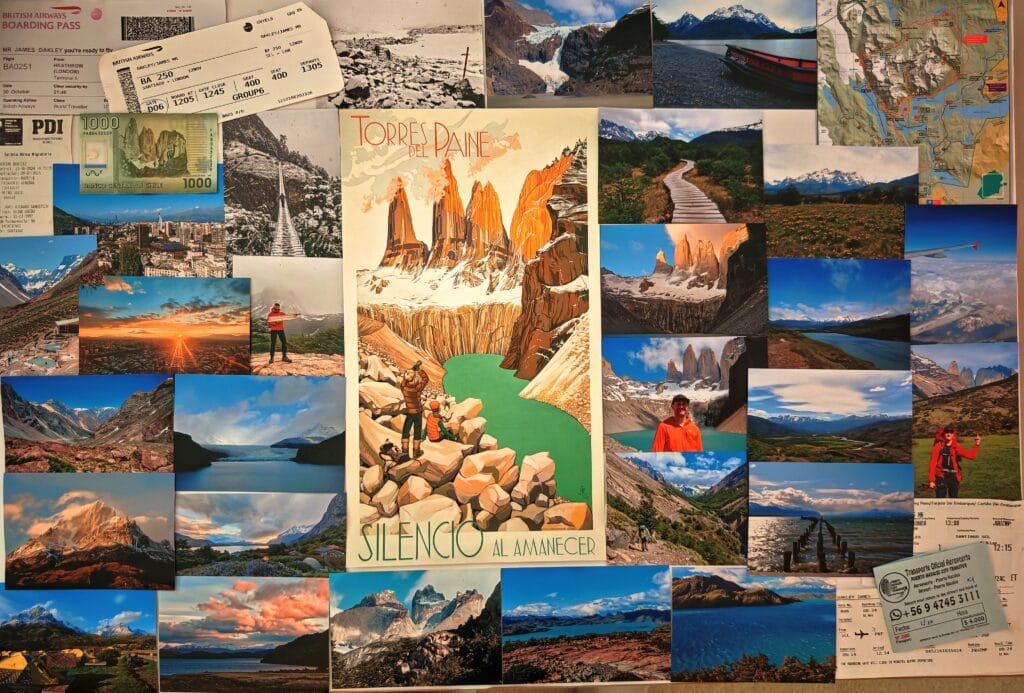
Are you ready to tackle the Torres del Paine O Circuit?
The Torres del Paine O Circuit is the ultimate Patagonia trekking experience – longer, harder, and wilder than the W Trek. It combines world-famous highlights with remote valleys and the thrilling John Gardner Pass. With good planning, gear, and preparation for Patagonia’s extreme weather, it’s one of the most rewarding multi-day treks on Earth.